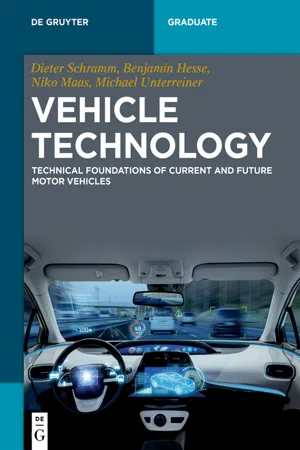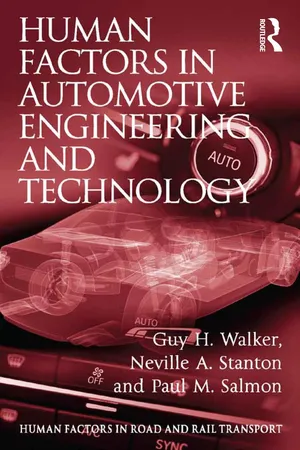Technology & Engineering
Automobile
An automobile is a self-propelled vehicle that is designed for transportation. It typically runs on roads and is powered by an internal combustion engine or electric motor. Automobiles have greatly impacted transportation and society, providing convenience and mobility to individuals and goods.
Written by Perlego with AI-assistance
3 Key excerpts on "Automobile"
- eBook - PDF
Vehicle Technology
Technical foundations of current and future motor vehicles
- Dieter Schramm, Benjamin Hesse, Niko Maas, Michael Unterreiner(Authors)
- 2020(Publication Date)
- De Gruyter Oldenbourg(Publisher)
1 Introduction and overview In the 125 years of its history, Automobile technology has become extremely com-plex in many areas. This includes the development and production of technology as well as methods of quality assurance. It has become an exemplary field of expertise, not only limited to pure engineering sciences. This development has significantly contributed to the fact that vehicle technology poses highly functional reliability and safety requirements on its products. In that sense, motor vehicles must remain operational under harsh environmental conditions. In addition, in case of fault, ve-hicles must be able to be brought back in a safe state by inexperienced operators. In addition, the car is made in mass production to produce quantities of millions of units at extremely low cost. Decades of improvement processes, as triggered by these requirements, have re-sulted in an extremely mature product group. As such, it is considered the model for many other products in terms of cost, function, and quality. Nevertheless, there are fields that are currently undergoing major changes in the area of vehicle technology. This applies, on the one hand, to the field of vehicle drive. The combustion engine, which is used for over 120 years, is though not nearly completely replaced in short and medium terms, but at least supplemented by electric and semielectric drives. The technical reasoning behind this is part of a detailed discussion in Chapter 6. On the other hand, there is a continuing development, driven by processes in electronics and sensor technology since the past decades: connected cars and the development of (advanced) driver assistance systems, which include purely supportive systems, further to systems that allow highly automated and, in the long term, fully automated driving. This topic is covered in Chapter 9. In addition to these specialized topics, the book also introduces the basic topics within current vehicle technology. - Guy H. Walker, Neville A. Stanton(Authors)
- 2017(Publication Date)
- CRC Press(Publisher)
Human Factors in Automotive Engineering and Technology 26 efficiency from a mechanical and electrical point of view and therefore have indirect effects. 42-volt Vehicle Electrics What the technology does: current vehicle electrical systems are powered from 12 volts in the case of passenger cars and light vans and 24 volts in the case of large commercial vehicles. The extra power of 42-volt vehicle electrics offers a host of benefits from an engineering perspective. Fundamentally it supports the implementation of even more technology and electrical actuation in future vehicles. Open Systems and the Corresponding Interfaces for Automotive Electronics (OSEK) What the technology does: a recurring theme is the ability of different technology sub-systems to be able to communicate with different sub-systems throughout the vehicle. OSEK is an example of a common electronic architecture for vehicles developed as a joint collaboration between European car manufacturers (OSEK, 2000). In a similar vein to the PC platform, the proposal is to standardise the electronic architecture of cars so that all electronic and microprocessor systems/ components (current and future) can integrate and communicate. This will mean, for example, that the collision avoidance system can interface directly with the engine management, airbag and ABS systems (regardless of manufacturer) to deliver optimal vehicle performance, especially in safety-critical scenarios. Summary Vehicle technologies have consequences not only for the interaction that the vehicle has with the road and other vehicles, but also for the interaction between the car and driver. What should be clear is that the whole issue is much more complex than merely putting yet more technology into vehicles, despite the temptation to do so.- eBook - PDF
Tinkering
Consumers Reinvent the Early Automobile
- Kathleen Franz(Author)
- 2011(Publication Date)
- University of Pennsylvania Press(Publisher)
Introduced in the first decades of the Machine Age the Automobile entered a culture already distinctly and intimately involved with technology. 52 In the late nine-teenth century, a host of new technologies restructured everyday life, such as the telephone, the streetcar, and the electric light. 53 Even as control over technology became the province of trained scientists, engi-neers, and planners, the products of mass production spurred enthusi-asm for both technology and mechanical know-how among middle-class Americans with little technical training. 54 Personal technologies, from telephones to wireless radios, fostered an ‘‘almost unqualified enthusi-asm’’ for technology among Americans in the 1910s and 1920s. 55 As the artifacts of the machine age proliferated, technological dis-course permeated American life from modernist literature to middle-brow magazines. The authors of American modernism embraced technology even as they critiqued it. 56 Sinclair Lewis’s Babbitt, for instance, lived in a landscape irrevocably shaped by skyscrapers, tele-graph wires, and electric razors. Wholly uncritical of technology, Babbitt thanked the ‘‘God of Progress’’ when he pulled on his BVDs or stepped into his Automobile. 57 By 1929, cultural critic Waldo Frank declared that the machine in America had given rise to a cult of power based on tech-nology; the machine had become an instrument of corporate power and a ‘‘household idol.’’ 58 If the literary elite criticized technology, popular literature cultivated Americans’ enthusiasm for new gadgets, machines, and electronic devices. Journals such as Popular Mechanics , serial fiction such as the Tom Swift books, and a host of other sources encouraged Automobiles in the Machine Age 9 amateur ingenuity in America.
Index pages curate the most relevant extracts from our library of academic textbooks. They’ve been created using an in-house natural language model (NLM), each adding context and meaning to key research topics.


